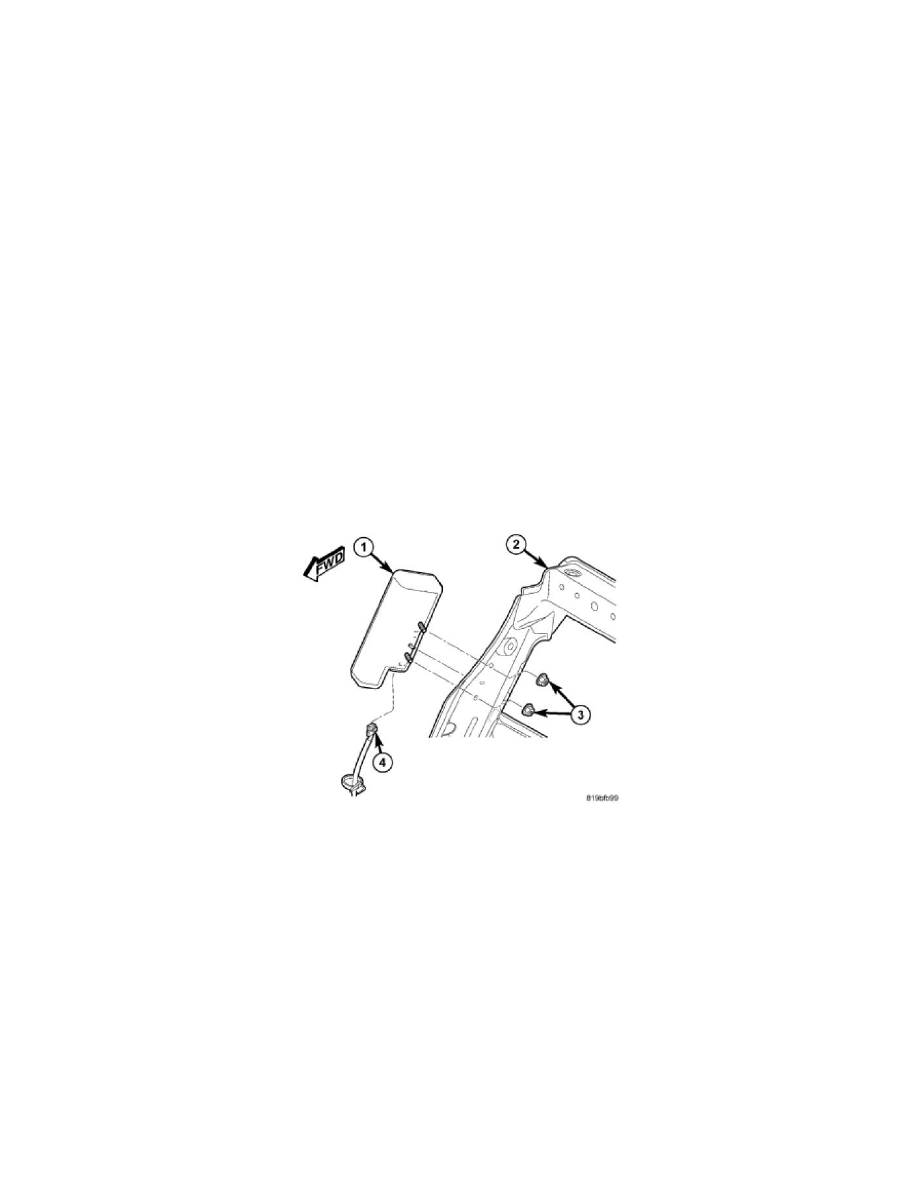Wrangler 2WD V6-3.8L (2008)

8. Working through the access hole in the top of the instrument panel (1) between the windshield and the forward edge of the passenger airbag door
(3), tighten the nut that secures the passenger airbag upper bracket and the instrument panel armature to the stud near the windshield fence line.
Tighten the nut to 6 Nm (55 in. lbs.).
9. Reinstall the trim plug (2) into the access hole in the top of the instrument panel.
WARNING: DO NOT CONNECT THE BATTERY NEGATIVE CABLE. PERSONAL INJURY OR DEATH MAY RESULT IF THE
SYSTEM TEST IS NOT PERFORMED FIRST. FOR THE SYSTEM TEST, See: Powertrain Management/Computers and Control
Systems/Testing and Inspection/Diagnostic Trouble Code Tests and Associated Procedures/Verification Tests/Supplemental Restraints
Verification Test
Removal
REMOVAL
WARNING: To avoid serious or fatal injury on vehicles equipped with airbags, disable the Supplemental Restraint System (SRS) before
attempting any steering wheel, steering column, airbag, seat belt tensioner, impact sensor, or instrument panel component diagnosis or service.
Disconnect and isolate the battery negative (ground) cable, then wait two minutes for the system capacitor to discharge before performing
further diagnosis or service. This is the only sure way to disable the SRS. Failure to take the proper precautions could result in accidental
airbag deployment.
WARNING: To avoid serious or fatal injury when removing a deployed airbag, rubber gloves, eye protection, and a long-sleeved shirt should
be worn. There may be deposits on the airbag unit and other interior surfaces. In large doses, these deposits may cause irritation to the skin and
eyes.
NOTE: The following procedure is for replacement of an ineffective or damaged seat airbag. If the airbag is ineffective or damaged, but not
deployed, review the recommended procedures for handling non-deployed supplemental restraints. See: Service and Repair. If the seat airbag
has been deployed, review the recommended procedures for service after a supplemental restraint deployment before removing the airbag from
the vehicle. See: Repairs and Inspections Required After a Collision/Service and Repair.
1. Position the front seat to its most forward position for easiest access to the front seat back.
2. Disconnect and isolate the battery negative cable. Wait two minutes for the system capacitor to discharge before further service.
3. Fold the seat back rearward for easiest access to the J-hook retainers at the base of the seat back trim cover
4. Disengage the J-hook retainers that secure the front and rear lower edges of the seat back trim cover to each other at the base of the seat back.
5. Fold the seat back forward for easiest access to the back of the seat back trim cover
6. Remove the recliner handle and, on the passenger side only, the easy entry handle from the outboard side of the seat.
7. Pull up the front and rear lower edges of the seat back trim cover far enough to access the seat airbag unit on the outboard side of the seat back
frame.
CAUTION: Do not pull on the seat airbag jumper wire harness (4) or pry on the connector insulator to disengage the connector from the
seat airbag (1) inflator connector receptacle. Improper removal of this jumper wire and its connector insulator can result in damage to
the airbag circuits or the connector insulator.
8. Reach between the seat back trim cover and the foam pad on the outboard side of the seat back frame to access and disconnect the seat airbag
jumper wire harness connector from the seat airbag inflator. Squeeze the black latch tabs on each side of the connector insulator, then pull the
insulator straight out from the airbag inflator initiator to disconnect it from the connector receptacle.
CAUTION: During removal of the seat airbag, be certain not to tear or damage the sewn nylon pouch integral to the inside of the seat
back trim cover that contains the seat airbag. If the nylon pouch or the trim cover are torn or damaged, the entire front seat back trim
